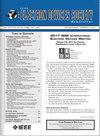低温下Si - n- mosfet的热载流子降解
IF 2.4
3区 工程技术
Q3 ENGINEERING, ELECTRICAL & ELECTRONIC
引用次数: 0
摘要
实验研究了低温下si - mosfet的热载流子降解(HCD)。在4 K和300 K下对器件施加应力,然后在4 K到300 K之间进行温度相关表征,以评估降解机制。结果表明,在4 K时,HCD对电流电压特性的影响主要归因于带边状态,而在300 K时,HCD对电流电压特性的影响主要归因于深态。尽管HCD发生的温度很高,但两种状态都是由热载流子同时诱导的。悬空键的氘终止即使在4 K时也会减轻HCD,其中由带边状态引起的降解。这些结果表明,为了充分理解材料的退化行为,应将带边态和深态结合起来考虑,而不是单独考虑。本文章由计算机程序翻译,如有差异,请以英文原文为准。
Hot Carrier Degradation in Si n-MOSFETs at Cryogenic Temperatures
This study experimentally investigated hot carrier degradation (HCD) in Si-MOSFETs at cryogenic temperatures. Stress was applied to the devices at 4 K and 300 K, followed by temperature-dependent characterization from 4 K to 300 K to evaluate the degradation mechanism. The results indicated that at 4 K, the effect of HCD on current-voltage characteristics is attributable to band-edge states, whereas at 300 K, it is primarily due to deep states. Despite the temperature at which HCD occurred, both states are induced simultaneously by hot carriers. Deuterium termination of dangling bonds mitigates HCD even at 4 K, where degradation is caused by band-edge states. These results suggest that the band-edge states and deep states should be considered in conjunction, rather than in isolation, to fully understand the degradation behavior.
求助全文
通过发布文献求助,成功后即可免费获取论文全文。
去求助
来源期刊

IEEE Journal of the Electron Devices Society
Biochemistry, Genetics and Molecular Biology-Biotechnology
CiteScore
5.20
自引率
4.30%
发文量
124
审稿时长
9 weeks
期刊介绍:
The IEEE Journal of the Electron Devices Society (J-EDS) is an open-access, fully electronic scientific journal publishing papers ranging from fundamental to applied research that are scientifically rigorous and relevant to electron devices. The J-EDS publishes original and significant contributions relating to the theory, modelling, design, performance, and reliability of electron and ion integrated circuit devices and interconnects, involving insulators, metals, organic materials, micro-plasmas, semiconductors, quantum-effect structures, vacuum devices, and emerging materials with applications in bioelectronics, biomedical electronics, computation, communications, displays, microelectromechanics, imaging, micro-actuators, nanodevices, optoelectronics, photovoltaics, power IC''s, and micro-sensors. Tutorial and review papers on these subjects are, also, published. And, occasionally special issues with a collection of papers on particular areas in more depth and breadth are, also, published. J-EDS publishes all papers that are judged to be technically valid and original.
 求助内容:
求助内容: 应助结果提醒方式:
应助结果提醒方式:


